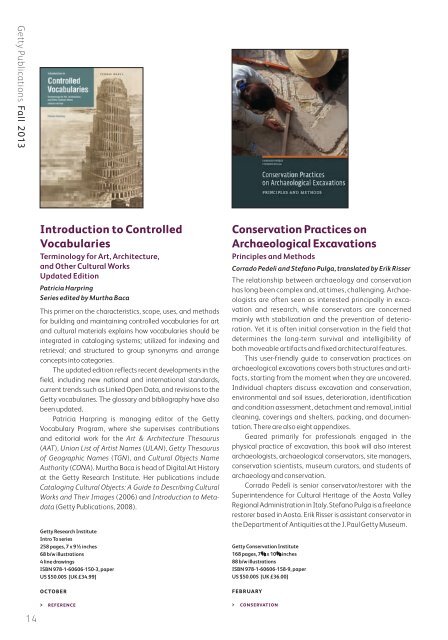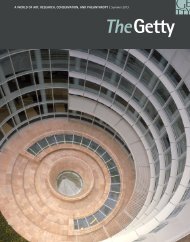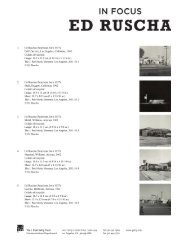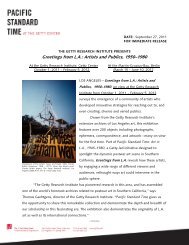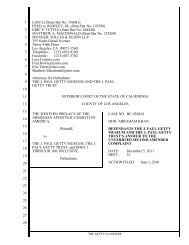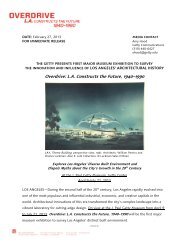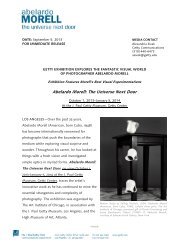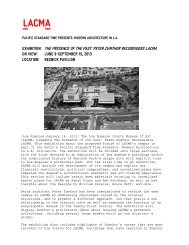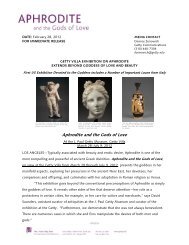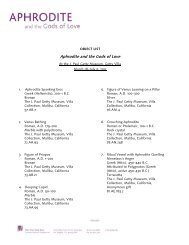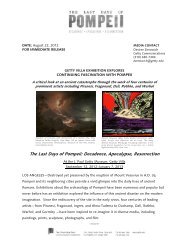Getty Publications Fall 2013 - News from the Getty
Getty Publications Fall 2013 - News from the Getty
Getty Publications Fall 2013 - News from the Getty
Create successful ePaper yourself
Turn your PDF publications into a flip-book with our unique Google optimized e-Paper software.
<strong>Getty</strong> <strong>Publications</strong> <strong>Fall</strong> <strong>2013</strong><br />
14<br />
Introduction to Controlled<br />
Vocabularies<br />
Terminology for Art, Architecture,<br />
and O<strong>the</strong>r Cultural Works<br />
Updated Edition<br />
Patricia Harpring<br />
Series edited by Murtha Baca<br />
This primer on <strong>the</strong> characteristics, scope, uses, and methods<br />
for building and maintaining controlled vocabularies for art<br />
and cultural materials explains how vocabularies should be<br />
integrated in cataloging systems; utilized for indexing and<br />
retrieval; and structured to group synonyms and arrange<br />
concepts into categories.<br />
The updated edition reflects recent developments in <strong>the</strong><br />
field, including new national and international standards,<br />
current trends such as Linked Open Data, and revisions to <strong>the</strong><br />
<strong>Getty</strong> vocabularies. The glossary and bibliography have also<br />
been updated.<br />
Patricia Harpring is managing editor of <strong>the</strong> <strong>Getty</strong><br />
Vocabulary Program, where she supervises contributions<br />
and editorial work for <strong>the</strong> Art & Architecture Thesaurus<br />
(AAT), Union List of Artist Names (ULAN), <strong>Getty</strong> Thesaurus<br />
of Geographic Names (TGN), and Cultural Objects Name<br />
Authority (CONA). Murtha Baca is head of Digital Art History<br />
at <strong>the</strong> <strong>Getty</strong> Research Institute. Her publications include<br />
Cataloging Cultural Objects: A Guide to Describing Cultural<br />
Works and Their Images (2006) and Introduction to Metadata<br />
(<strong>Getty</strong> <strong>Publications</strong>, 2008).<br />
<strong>Getty</strong> Research Institute<br />
Intro To series<br />
258 pages, 7 x 9 ½ inches<br />
68 b/w illustrations<br />
4 line drawings<br />
ISBN 978-1-60606-150-3, paper<br />
US $50.00S [UK £34.99]<br />
october<br />
Reference<br />
Conservation Practices on<br />
Archaeological Excavations<br />
Principles and Methods<br />
Corrado Pedelì and Stefano Pulga, translated by Erik Risser<br />
The relationship between archaeology and conservation<br />
has long been complex and, at times, challenging. Archaeologists<br />
are often seen as interested principally in excavation<br />
and research, while conservators are concerned<br />
mainly with stabilization and <strong>the</strong> prevention of deterioration.<br />
Yet it is often initial conservation in <strong>the</strong> field that<br />
determines <strong>the</strong> long-term survival and intelligibility of<br />
both moveable artifacts and fixed architectural features.<br />
This user-friendly guide to conservation practices on<br />
archaeological excavations covers both structures and artifacts,<br />
starting <strong>from</strong> <strong>the</strong> moment when <strong>the</strong>y are uncovered.<br />
Individual chapters discuss excavation and conservation,<br />
environmental and soil issues, deterioration, identification<br />
and condition assessment, detachment and removal, initial<br />
cleaning, coverings and shelters, packing, and documentation.<br />
There are also eight appendixes.<br />
Geared primarily for professionals engaged in <strong>the</strong><br />
physical practice of excavation, this book will also interest<br />
archaeologists, archaeological conservators, site managers,<br />
conservation scientists, museum curators, and students of<br />
archaeology and conservation.<br />
Corrado Pedelì is senior conservator/restorer with <strong>the</strong><br />
Superintendence for Cultural Heritage of <strong>the</strong> Aosta Valley<br />
Regional Administration in Italy. Stefano Pulga is a freelance<br />
restorer based in Aosta. Erik Risser is assistant conservator in<br />
<strong>the</strong> Department of Antiquities at <strong>the</strong> J. Paul <strong>Getty</strong> Museum.<br />
<strong>Getty</strong> Conservation Institute<br />
168 pages, 7 5 ⁄8 x 10 3 ⁄8 inches<br />
88 b/w illustrations<br />
ISBN 978-1-60606-158-9, paper<br />
US $50.00S [UK £36.00]<br />
february<br />
conservation


